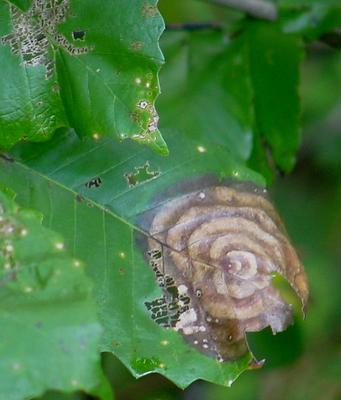
Here is is again, on a different leaf from the same tree (a Chestnut Oak).

This is the kind of thing that we got calls for all the time at the Master Gardener Hotline, where I volunteered this past summer.
But without all the Cooperative Extension's plant books and other resources, I'm at a loss. (And this is one of those occasions where Google brings up too many choices to be useful.)


13 comments:
Well, you got me curious. I think I've found it.
It's called Zonate Leaf Spot, and it seems to affect a large population of trees.
I didn't find a good specific info site to link - they are all general - but you can go puddling with the name and see what you find.
Jenn I did see that one, but thought that might not be it due to the size of the spots. The leaves in this picture are very large... the little "targets" are several inches across, and there is just one per leaf. Every picture I saw of the zonate leaf spot shows smaller spots, and several per leaf.
I'd be curious to know what everyone else thinks... I'm certainly no botanist.
looks like an alien invasion to me...you better be careful...you might be next...yipes!
Oh, I know what it is!
Attack of the Steve Wonder Album Cover art fungus.
Wow, it's probably a bad thing (I'm going to google zonate leaf spot here in a minute)but it sure is pretty.
Is it caused by leafminers - the larvae of any of a number of insect species which munch their way around inside the layers of leaves? Some just tunnel and munch randomly but others make spirals.
I wouldn't have a clue what it is, but it sure is cool looking.
Grows outward like a fungus. That wasn't really very helpful was it? I meant to say, that circle thing sure is purty.
It does look sort of alien, doesn't it? Maybe they are really tiny and that's the scorch pattern their landing craft make.
Or else someone has been in the woods playing pop music to my trees...
Sara, not sure - will have to check that out. It looked more like fungus but I could be wrong.
I was kind of hoping Ron might come by and know for sure. :)
Hah. Here I am in response to being goosed, and I haven't a clue. I've never seen it out here, but that doesn't mean we don't have it... whatever it is.
I do know that Bob Raabe would call it "beautiful!" He's a plant pathologist prof emeritus at UC Berkeley, who runs a free clinic monthly. He actually cultivates some plants in his yard because they're prone to diseases he likes. He also taught (not at UC) the only course I've ever flunked in my life, but that's another story entirely.
I wish I had an e-mail address for him.
I'll agree it looks fungal -- now that you have the search image, are you seeing a lot of it? It might be hard to research because, from the look of it, it's not dangerous. It's on a deciduous leaf and it's late in the season. If that's typical, it's not something the ag-hort types would get excited about.
Handsome, tho'.
Jenn's zonate leaf spot reference really pegs it well. Was it woody in any way, or does it just look that way?
I love galls and leaf spots - I wish I could find my pic of maple leaves with a brilliant red and yellow bullseye much like that.
Plants do have an immune system, of a sort, called the hypersensitive response. They have proteins that recognize invasion and self-destruct the affected plant cells so it doesn't go any further. That could be what this, or it could be more like an encystment.
Ron, no, not seeing a lot of it... guess that's a good thing.
Wayne I don't think it's woody, but this was taken across a ditch with telephoto, and I didn't get close enough to touch it.
Yep it's purdy anyway, whatever it is!
This is too bizarre... I was just now (Dec 7, 2006) watching a tv program of some master gardener classes from California. The man showed a pic of a leaf with a fungus that looked just like this, and called it Phyllosticta. Guess who the man was. Bob Raabe! (Who Ron mentioned above.) And he does call a lot of fungi "beautiful"!
Anyway apparently there's more than one phyllosticta, and not all of them look like that. But I wanted to come back to this post and stick that name on it, so I could always look it up again later.
Post a Comment